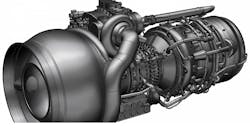The first Future Affordable Turbine Engine (FATE) has completed testing at the GE Aviation military engine center in Lynn, Mass., having demonstrated a 35% reduction in specific fuel consumption (SFC); an 80% improvement in power-to-weight; a 20% improvement in design life; and a 45% reduction in production and maintenance costs relative to currently fielded engines.
A second FATE engine will begin testing in 2018.
The FATE engine program was launched in 2011 to develop a 5,000-10,000-shp class turobshaft/turboprop engine, applicable to current military aircraft and future rotorcraft requirements, such as the DoD’s Future Vertical Lift (FVL) program.
In addition to increased hot-and-high payload and performance, the Army expects the new engine to provide extended range and endurance.
The technologies being tested also may be incorporated into new engines, including the T901 that GE Aviation is developing in the Improved Turbine Engine Program (ITEP), or upgrades to existing engines.
The first engine-level test followed the successful tests of the engine’s compressor, combustor, and turbine rig tests.
According to GE Aviation, the FATE compressor rig recorded the highest single-spool compressor pressure ratio in its history, and GE's most extensive use of ceramic matrix composites (CMCs) in the combustion module. The CMC combustion dome and liners allow “unprecedented” high-temperature capability and weight reduction, the engine developer stated.
The FATE turbine rig was built using additive manufacturing techniques, to speed construction and cut development costs.
"We're thrilled with the results from the first FATE full engine test, which completed all primary objectives with more than 40 hours of run time and nearly 1,000 steady-state and transient data points," stated Harry Nahatis, vice president and general manager of GE Aviation's Turboshaft Engine Department. “This risk-reduction vehicle is a key step in the program towards our final build and performance demonstration.”
About the Author
Robert Brooks
Content Director
Robert Brooks has been a business-to-business reporter, writer, editor, and columnist for more than 20 years, specializing in the primary metal and basic manufacturing industries.
